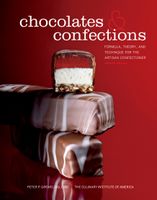Advertisement
Glucose Syrup
By Peter Greweling and Culinary Institute of America
Published 2007


Glucose syrup is the legal name for nutritive sweeteners made by the hydrolysis of edible starch. The name of the source starch may replace the word glucose in the name of the syrup; for example, corn syrup is a permissible name for glucose syrup derived from cornstarch. Glucose syrups are made by hydrolyzing the long dextrose chains (polysaccharides) contained in starch and converting them into shorter chains of dextrose molecules. The process of breaking the bonds between dextrose molecules during syrup manufacture is called conversion, and it is accomplished with the use of acids or enzymes, or both. (See conversion diagrams.) Most American glucose syrups are made from cornstarch because of its wide availability and low cost and are commonly known as corn syrup. In Europe most glucose syrups are made from wheat or potato starch, but there is effectively no difference among syrups made from the starches of corn, wheat, or potatoes.



